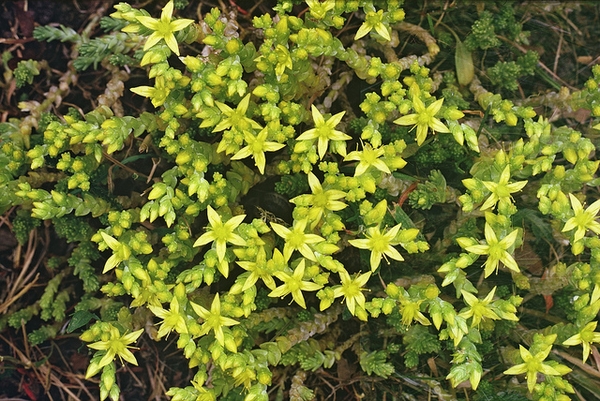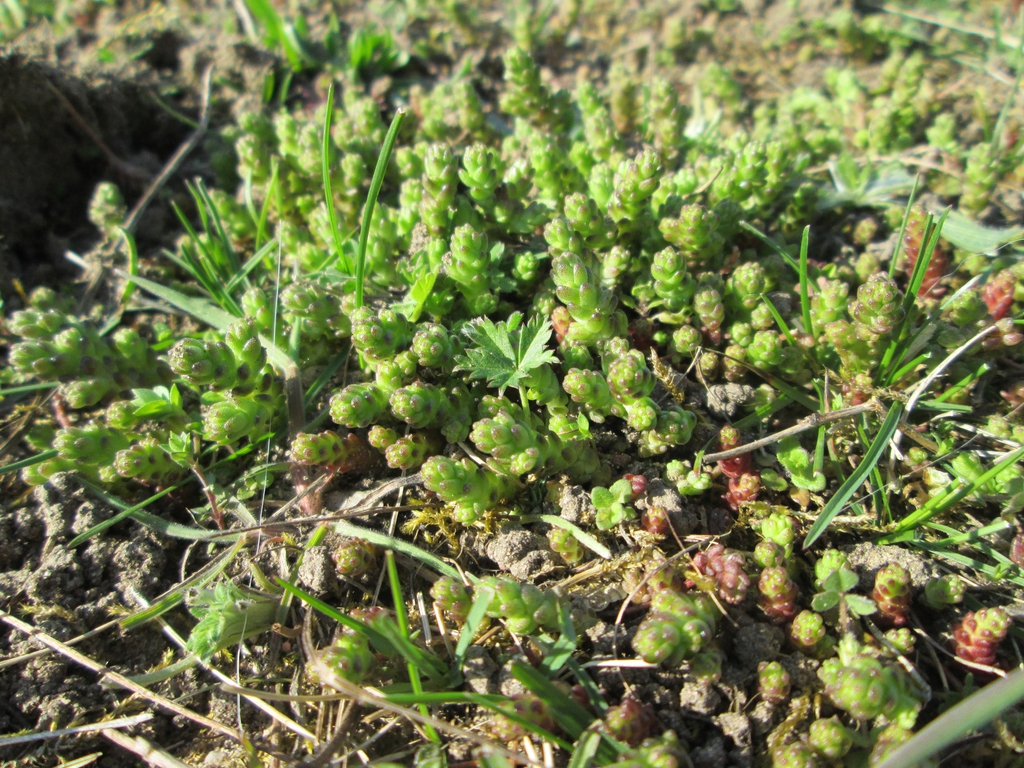Sedum acre
Common Name(s):
- Phonetic Spelling
- SEE-dum AY-ker
- Description
-
Moss stonecrop, is a small, hardy, highly salt tolerant plant in the Crassulaceae (succulent) family native to Europe. In nature, moss stonecrop is often found in sunny situations on limestone hills, rocks, and walls, especially near the sea. The genus name comes from the Latin word sedeo meaning to sit in reference to the habit of many of the sedums species to lounge out and sprawl over rocks.
The plant has tiny fleshy conical green leaves that overlap eachother giving a scale like appearance. Delicate star shaped yellow flowers hover above the leaves for most of the summer. When grown outdoors, site for sun to part sun in well-drained soil. It seldom needs watering, but will grow in moist soils with good drainage. If growing in a container, use coarse, well-drained soil, preferably a cactus mix. The leaves tend to fall off easily; however, the fallen leaves can be used to propagate new plants.
This plant tolerates maritime exposure, rocky and poor soils, and establishes itself quickly. The succulent leaves make it drought and dry soil tolerant and also make it attractive even through the winter months. This plant is resistant to browsing by deer and rabbits.
Moss stonecrop is low to the ground, mat forming, and spreads aggressively and can be used for ground cover in a sunny position; although it can overwhelm other plants of similar height. Grown it as a houseplant with bright direct light from a window or grow light. This species of Sedum, like many of its genus, tolerates only occasional foot traffic but can still make a suitable lawn alternative to areas with light traffic. Mass plant it in hot areas, or rock gardens.
Insects, Diseases, and Other Plant Problems: No serious diseases or insect problems, except for occasional slugs and snails. Avoid wet or poorly drained conditions. It can be weedy and aggressive in some situations.
VIDEO Created by Elisabeth Meyer for "Houseplants, Succulents, and Cacti", a plant identification course offered in partnership with Longwood Gardens.
- Profile Video:
- See this plant in the following landscape:
- Cultivars / Varieties:
-
- 'Aurem'
moss-like, tiny green leaves, new growth has golden tones, yellow blooms - 'Octoberfest'
mat-forming, green leaves with creamy white flowers - 'Yellow Queen'
creeping, low-growing habit, green and yellow foliage, yellow blooms
- 'Aurem'
- 'Aurem', 'Octoberfest', 'Yellow Queen'
- Tags:
















- Cultivars / Varieties:
-
- 'Aurem'
moss-like, tiny green leaves, new growth has golden tones, yellow blooms - 'Octoberfest'
mat-forming, green leaves with creamy white flowers - 'Yellow Queen'
creeping, low-growing habit, green and yellow foliage, yellow blooms
- 'Aurem'
- 'Aurem', 'Octoberfest', 'Yellow Queen'
- Tags:
-
-
Attributes:
- Genus:
- Sedum
- Species:
- acre
- Family:
- Crassulaceae
- Life Cycle:
- Perennial
- Recommended Propagation Strategy:
- Division
- Leaf Cutting
- Seed
- Country Or Region Of Origin:
- Greenland, Eastern Europe to Mediterranean, Balkans and Caucasus
- Distribution:
- Britain, Canada, Eastern United States south to Carolina, upper mid-West, and Northwest.
- Wildlife Value:
- Attracts butterflies
- Play Value:
- Attractive Flowers
- Attracts Pollinators
- Textural
- Edibility:
- Stems and leaves can be eaten, but when ingested in large quantities, can cause stomach upset.
- Dimensions:
- Height: 0 ft. 1 in. - 0 ft. 4 in.
- Width: 1 ft. 0 in. - 2 ft. 0 in.
-
-
Whole Plant Traits:
- Plant Type:
- Ground Cover
- Herbaceous Perennial
- Houseplant
- Perennial
- Succulent
- Woody Plant Leaf Characteristics:
- Broadleaf Evergreen
- Deciduous
- Habit/Form:
- Creeping
- Dense
- Horizontal
- Spreading
- Growth Rate:
- Rapid
- Maintenance:
- Low
- Texture:
- Medium
-
-
Cultural Conditions:
- Light:
- Full sun (6 or more hours of direct sunlight a day)
- Partial Shade (Direct sunlight only part of the day, 2-6 hours)
- Soil Texture:
- Sand
- Shallow Rocky
- Soil pH:
- Alkaline (>8.0)
- Neutral (6.0-8.0)
- Soil Drainage:
- Good Drainage
- Moist
- Occasionally Dry
- Available Space To Plant:
- 12 inches-3 feet
- NC Region:
- Coastal
- Mountains
- Piedmont
- USDA Plant Hardiness Zone:
- 3a, 3b, 4a, 4b, 5a, 5b, 6a, 6b, 7a, 7b, 8a, 8b, 9a, 9b
-
-
Fruit:
- Fruit Type:
- Capsule
-
-
Flowers:
- Flower Color:
- Gold/Yellow
- Flower Inflorescence:
- Cyme
- Flower Value To Gardener:
- Showy
- Flower Bloom Time:
- Summer
- Flower Shape:
- Star
- Flower Petals:
- 4-5 petals/rays
- Flower Size:
- < 1 inch
- Flower Description:
- Small, terminal clusters of tiny, star-shaped, five-petaled, yellow flowers (each to 1/2 inch across) bloom in flat terminal cymes just above the foliage June to August.
-
-
Leaves:
- Woody Plant Leaf Characteristics:
- Broadleaf Evergreen
- Deciduous
- Leaf Color:
- Green
- Leaf Feel:
- Fleshy
- Leaf Value To Gardener:
- Long-lasting
- Leaf Type:
- Simple
- Leaf Arrangement:
- Opposite
- Leaf Shape:
- Ovate
- Leaf Margin:
- Entire
- Hairs Present:
- No
- Leaf Length:
- < 1 inch
- Leaf Width:
- < 1 inch
- Leaf Description:
- Thick cover of blunt, conical, pale green leaves (each to only 1/4 inch long) overlapping eachother along the stem.
-
-
Stem:
- Stem Is Aromatic:
- No
- Stem Cross Section:
- Round
- Stem Description:
- low, thick stems
-
-
Landscape:
- Landscape Location:
- Container
- Houseplants
- Lawn
- Naturalized Area
- Recreational Play Area
- Rock Wall
- Slope/Bank
- Landscape Theme:
- Butterfly Garden
- Children's Garden
- Pollinator Garden
- Rock Garden
- Design Feature:
- Border
- Mass Planting
- Attracts:
- Butterflies
- Pollinators
- Songbirds
- Resistance To Challenges:
- Deer
- Drought
- Foot Traffic
- Poor Soil
- Rabbits
- Salt
- Problems:
- Contact Dermatitis
- Weedy










